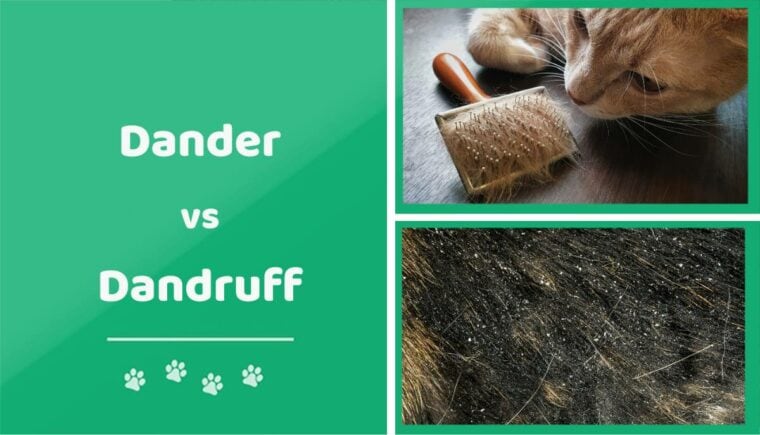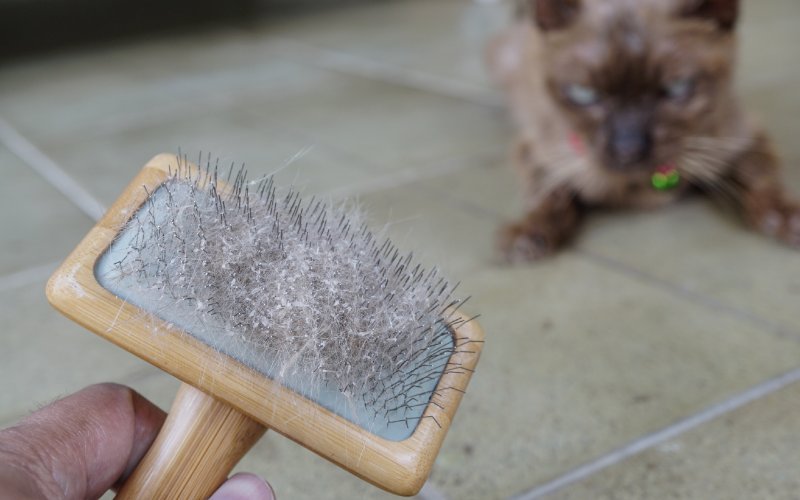
Click to Skip Ahead
Dander and dandruff have a lot in common. Both have very similar names. Both are made of dead skin cells. And both dander and dandruff can be major contributors to allergies in humans. But they also have some pretty big differences. Cat dander is a totally healthy, normal part of owning a cat, while dandruff is a sign that your cat’s skin is unhealthy.
They also can affect allergies in very different ways. Because of these major differences, it’s important to know how to recognize when your cat’s skin goes from producing healthy, normal dander to making dandruff. This article will go through some of the differences between dander and dandruff and some common causes and treatments for dandruff.
Overview of Dander

What Is Dander?
When skin cells die, they are shed as dander. Dander flakes off of the skin in pieces too small to see with the human eye. Dander is totally normal and healthy—in fact, all mammals and birds lose skin cells regularly. The skin is made up of several layers of cells, with new cells being produced underneath. The cells on the outer layer of the skin die off and are shed as dander, and the next layer down replaces them. This helps keep your skin healthy and clean, as well as your cat’s skin.
In cats, dander is often caught in its fur. Then your cat can clean it when grooming, or it can stick to the hair as it sheds. Dander isn’t generally visible to the naked eye, and if you can see it, it would just look like a speck of dust.
Do All Cats Have Dander?
Yes, all cats have dander. Dander is important for removing your cat’s skin as it ages—the mammal equivalent of a snake shedding its skin. If your cat were to stop producing dander, dead skin would build up and become pretty gross before long.

Dander and Allergies
You often hear dander talked about in relation to allergies. Cat allergies are a reaction to the Fel D1 protein, a common protein produced by cats. This protein is actually not found in the fur and skin originally—it comes from cat saliva. Protein production varies from cat to cat, with some breeds making less of the protein. Kittens also make less Fel D1 and female cats tend to produce less than males.
As your cat grooms itself, the protein is deposited on fur and skin. As your cat sheds dander, bits of the protein are shed as well. This is a big problem for some people with cat allergies. Because the amount of protein in a speck of dander is so small, many people with mild allergies won’t react to a little bit of dander. But if you’ve ever walked into a room and started having a reaction even though you haven’t had direct contact with a cat, dander is probably to blame. These microscopic bits of protein-covered skin are causing a reaction, and since they can float through the air, you might not ever even see the cat.
Overview of Dandruff

What Is Dandruff?
Dandruff is also made of dead skin cells, but it’s different from dander. Instead of flaking off in microscopic pieces, dandruff comes off in larger chunks of skin. These pieces of skin can be anywhere from the size of grains of sand to about an eighth of an inch long, and they often resemble white fishflakes. Dandruff often gets caught in your cat’s hair, leaving it with a messy, dirty appearance. It can also get shed wherever your cat walks or sits. Unlike dander, dandruff is abnormal in cats and should be treated if it shows up.
What Causes Dandruff?
Dandruff is caused when the skin is too dry or oily to shed properly and instead comes off in larger clumps or flakes. There are several different causes of dandruff, but the three main causes are poor grooming, diet issues, and parasites.
Dandruff is common in elderly or overweight cats who can’t groom themselves properly. In areas where your cat struggles to groom, oils in the skin won’t be properly distributed, and your cat’s skin health will begin to suffer. This can lead to dandruff as the skin begins to flake and clump.
Another common cause of dandruff is diet sensitivity. Cats with dandruff may not be producing enough skin oils because of a lack of fat in their diet, or they may be reacting to an ingredient they are sensitive to. If your cat can’t produce enough oils for their skin, they’ll have dry, flaking skin no matter how well they groom.
Cats can also get dandruff because of a health problem such as a parasite or fungal infection. These skin issues can irritate and kill off the skin, leading to dandruff. They can also lead to other health problems.

Dandruff and Allergies
Like dander, dandruff can be covered by the Fel D1 protein and so contact with dandruff can cause allergic reactions. But reactions are a little less common in dandruff because it is heavier and doesn’t float through the air like dander. This means you’ll probably have to touch it to have a reaction. Despite this, dandruff can be a serious allergen, giving us one more reason to treat it.
Treating Dandruff
If your cat has dandruff, you’ll want to do what you can to treat it and help your cat’s skin become healthy again. This means finding the underlying cause of dandruff. Regular grooming is a good way to start because the majority of dandruff is caused by poor grooming. You can also use regular grooming to help you check for fleas or signs of infection. Any sign of fleas or parasites will require treatment to help your cat get rid of the underlying problem before the dandruff gets better.
You can also look for different food to make sure that your cat’s nutritional needs are being met if grooming alone doesn’t work. Look for foods advertised as “sensitive skin” foods and foods that have omega fatty acids. These will help your cat produce the necessary oils to relieve irritated skin.
If grooming, parasite treatment, and diet changes don’t help out, another option is to look for dandruff-treatment shampoos. Giving your cat an occasional bath with a shampoo meant to help with dandruff can rebalance the skin and help soothe and heal it. However, these shampoos may not always treat the underlying problems, so they shouldn’t be seen as the only solution.
Comparison
It's easy to get overwhelmed when you're looking for the perfect pet shampoo. The Hepper Pet Shampoo products are a great place to start because of their all-natural, pet-safe formula that is pH balanced for your pet's skin. Made with soothing ingredients like oatmeal and aloe vera, these shampoos are also free of phthalates, sulfates, dyes, and soaps. Both options will leave your pet clean, moisturized, and smelling like a day at the spa!
Here’s a quick guide to help you choose the right option for your pet’s next bath!
 |
 |
|
|---|---|---|
| Hepper Colloidal Oatmeal Pet Shampoo | Hepper Waterless No Rinse Pet Shampoo | |
| Natural Ingredients |
Natural Ingredients:
|
Natural Ingredients:
|
| Made in USA |
Made in USA:
|
Made in USA:
|
| Safe for cats & dogs |
Safe for cats & dogs:
|
Safe for cats & dogs:
|
| Soothes dry skin |
Soothes dry skin:
|
Soothes dry skin:
|
| Waterless, no rinsing required |
Waterless, no rinsing required:
|
Waterless, no rinsing required:
|
At Pet Keen, we've admired Hepper for many years, and decided to take a controlling ownership interest so that we could benefit from the outstanding designs of this cool cat company!

Conclusion
If you’re seeing flakes of skin in your cat’s fur, it’s probably dandruff. Unlike dander, which all cats produce, dandruff is highly visible and a sign that your cat has poor skin health. Although there are various underlying causes, most cases of dandruff are relieved by a combination of grooming and diet changes to help your cat be its healthiest self.
Featured Image Credit: Top – Dander (RJ22, Shutterstock) | Bottom – Dandruff (Nau Nau, Shutterstock)





